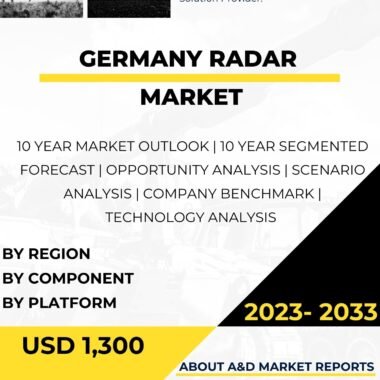Description
The China radar market has witnessed significant growth and development in recent years. With China’s focus on military modernization, national security, and infrastructure development, there has been a substantial demand for advanced radar systems. This market analysis provides an overview of the China radar market, including key players, market drivers, challenges, and future prospects.
The China radar market is characterized by the presence of both domestic and international players. Domestic companies, such as CETC (China Electronics Technology Group Corporation), CETC Avionics Co. Ltd., and CASIC (China Aerospace Science and Industry Corporation), have made significant contributions to the development, production, and supply of radar systems. These companies have invested in research and development to enhance the capabilities of their systems and meet the specific requirements of the Chinese military, civil aviation, and other sectors.
International players, including renowned radar manufacturers such as Thales Group, Raytheon Technologies Corporation, and Lockheed Martin Corporation, have also established collaborations and joint ventures in China. These partnerships have facilitated technology transfer, knowledge exchange, and joint development programs, contributing to the advancement of radar capabilities in China.
The market is driven by several factors. One of the primary drivers is China’s focus on enhancing its military capabilities and achieving information dominance. Radars play a crucial role in detecting, tracking, and identifying air, ground, and maritime targets. As China seeks to strengthen its defense capabilities and protect its national interests, the demand for advanced radar systems has grown.
Furthermore, China’s rapid infrastructure development, including the construction of airports, seaports, railways, and highways, has led to an increased demand for radar systems in civil applications. Radars are essential for air traffic control, weather monitoring, maritime surveillance, and border security. The growth in civil aviation and transportation sectors has significantly contributed to the demand for radar systems in China.
Technological advancements have played a crucial role in the growth of the China radar market. Domestic companies have focused on developing indigenous radar systems with improved range, accuracy, sensitivity, and electronic countermeasures (ECM) resistance. China has made significant progress in the development of various radar systems, including surveillance radars, weather radars, air defense radars, and synthetic aperture radars (SAR).
China has successfully developed and deployed advanced radar systems, such as the JY-26 counter-stealth surveillance radar, which can detect and track stealth aircraft. The development of the YLC-8B weather radar has enhanced China’s meteorological monitoring capabilities, enabling accurate weather forecasting and severe weather detection. Additionally, air defense radars, such as the SLC-7 and SLC-6, have been developed to provide early warning and detection of aerial threats.
Another driver of the China radar market is the export market. China has emerged as a significant exporter of radar systems, offering cost-effective solutions to countries seeking to enhance their defense capabilities or infrastructure development. The Belt and Road Initiative (BRI) has provided opportunities for China to export its radar systems to partner countries, expanding its market presence globally.
However, the China radar market also faces certain challenges. One of the primary challenges is the need for continuous research and development to keep pace with evolving threats and emerging technologies. As adversaries develop more advanced countermeasures and seek to disrupt radar systems, China must invest in innovation and advanced technologies to maintain its technological edge.
Additionally, the market faces challenges related to international export restrictions and intellectual property rights. The development and export of radar systems are subject to strict regulations due to security concerns. This can limit market opportunities and hinder collaboration with international partners.
Looking ahead, the future prospects for the China radar market are promising. China’s commitment to military modernization, infrastructure development, and national security will continue to drive investments in radar systems. Ongoing research and development efforts, collaborations between domestic companies and international partners, and the integration of emerging technologies, such as artificial intelligence (AI) and machine learning (ML), are expected to result in the introduction of more advanced and capable radar systems.
The integration of AI and ML technologies may shape the future of the market. AI-powered radar systems can improve target recognition, tracking accuracy, and overall operational efficiency. ML algorithms can analyze large volumes of radar data and provide actionable insights for enhanced situational awareness and decision-making.
In conclusion, the China radar market has witnessed significant growth driven by the country’s focus on military modernization, national security, and infrastructure development. Technological advancements, collaborations between domestic and international players, and the government’s commitment to indigenous defense capabilities have contributed to the development and deployment of advanced radar systems. Challenges related to evolving threats, export restrictions, and intellectual property rights need to be addressed. With ongoing research and development, collaborations, and the integration of emerging technologies, the future of the China radar market looks promising, with opportunities for further growth, innovation, and advancements in radar capabilities.




